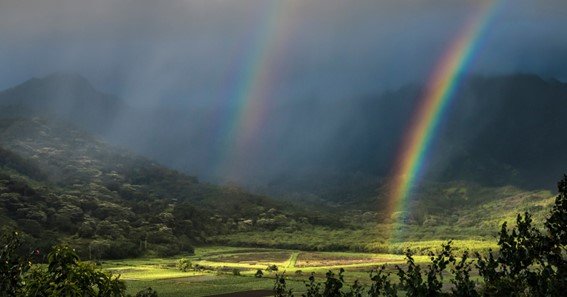Double rainbows are a spectacular natural display that captures the imagination and awe of anyone lucky enough to witness one. Unlike a single rainbow, a double rainbow features two arcs, one above the other, with the secondary arc displaying reversed colors. But what exactly causes a double rainbow?
The Science Behind Double Rainbows
A double rainbow occurs due to the way sunlight interacts with raindrops in the atmosphere. Here’s how it works:
- Primary Rainbow Formation: When sunlight enters a raindrop, it is refracted, or bent, at the surface. The light reflects off the inside of the droplet, and then it is refracted again as it exits. This process separates the light into its constituent colors, forming the primary rainbow that we see.
- Secondary Rainbow Formation: In the case of a double rainbow, the sunlight undergoes an additional reflection inside the raindrop before it exits. This second reflection causes the light to emerge at a different angle, creating a secondary, fainter rainbow above the primary one. Due to the second reflection, the order of colors in the secondary rainbow is reversed—red appears on the inside and violet on the outside.
- Visibility and Conditions: Double rainbows are most visible when the sun is low in the sky, such as in the early morning or late afternoon. Larger raindrops are also more likely to produce a clear and vivid secondary rainbow. The angle at which the observer sees the rainbow is crucial—generally, the sun needs to be behind the observer with rain in front.
FAQ
Why are the colors of the secondary rainbow reversed?
The colors in the secondary rainbow are reversed because the light undergoes two reflections inside the raindrop, altering the order of the colors.
How common are double rainbows?
While not extremely rare, double rainbows are less common than single rainbows due to the specific conditions required for their formation.
Why is the secondary rainbow fainter?
The secondary rainbow is fainter because the additional reflection causes more light to be lost, reducing its intensity.
Can a triple rainbow occur?
Yes, but triple rainbows are very rare. They occur when the light reflects three times inside the raindrop, creating a third arc that is usually very faint.
What time of day is best for seeing a double rainbow?
The best time to see a double rainbow is early morning or late afternoon, when the sun is lower in the sky, enhancing the contrast and visibility of the arcs.










